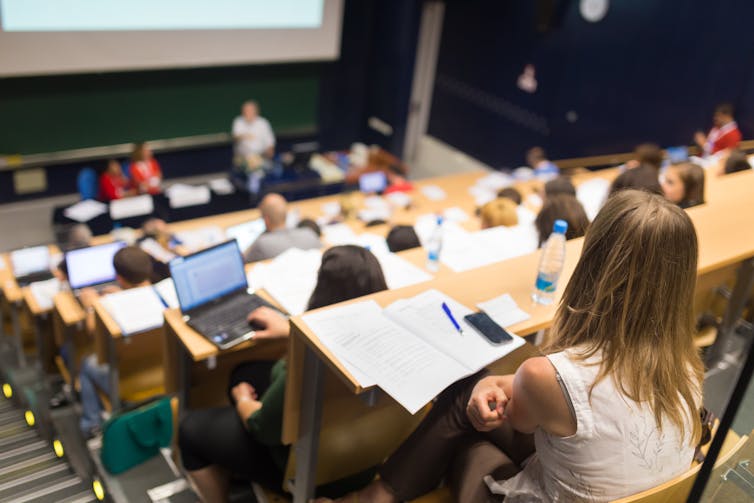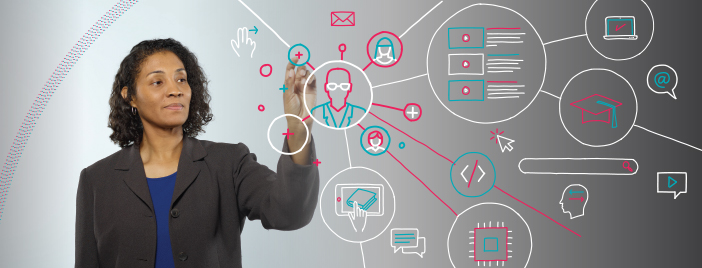John Fischetti, University of Newcastle
This essay is part of a series of articles on the future of education.
The nature of global communication (for better and worse) has changed. Virtually all young people in Australia spend an average of nine hours a day online and about three hours of that interacting on social media. That means they spend more time online than sleeping.
Smartphones and smart technologies are our personal assistants with diary, shopping, research, translation, social and telecommunications capabilities all a swipe away. As you read this, or have Siri read it to you, people are solving problems, writing music, dating, visiting a tele-nurse and conducting business – all online. It is the new normal.
Meanwhile, massive open online courses (MOOCs) offer tens of thousands of opportunities for people to be exposed to the best researchers, practitioners and university talent in the world. MOOCs are one example of our interconnected world, which allows expertise to be universal and accessible – anyone can learn what they want, where they want, when they want and how they want.

from shutterstock.com
If you want to study psychology, master computer coding or complete an MBA, why would you pay big fees to a large university to support its infrastructure costs and hear someone lecture in a huge hall, when you could watch the world’s best experts from the comfort of your apartment or on your phone, wherever you are?
To remain relevant, Australia’s universities will need to transform into very different entities, with new business models that foster innovation and embrace the interconnection technology offers. And they will need to do so quickly.
The old university model is becoming obsolete
The American business academic Clayton M. Christensen used the term “disruption” to discuss the implications of the massive changes to the student base of universities.
He likened the situation to how discount stores such as Target disrupted the business models of department stores like Myer and David Jones, capturing an increasing chunk of middle-class spending on everyday personal and household goods. Christensen challenged universities not to be like the big steel mills that are mostly relics of the past.
Similarly, US scholar Cathy N. Davidson has urged universities to abandon generic degrees and impersonal forms of teaching, to make university education more accessible and relevant.
In most university programs, a student completes courses in large facilities at mandated times. In the first year of many degrees, learning is primarily passive and assessment is typically in the form of easily marked exams.
The current university funding model is mainly based on the assumption completing multi-year undergraduate and postgraduate coursework degrees, broken into semesters or terms of 10-15 weeks, is still a relevant measure of learning.
This mode of “seat time” as learning is becoming obsolete. Learning in courses made of short chunks, certificates, or micro-credentialled mini units of study is growing as the preferred method for this generation of students and industry.
Some will say Australian universities are already on it, with innovation hubs, new academic products including micro-credentials and increasingly online delivery.

from shutterstock.com
But these features are generally bolted on to the status-quo funding model, based on teaching the first year of a program cheaply to drive profit that can be spent on more engagement-oriented upper-level courses, and to support research and infrastructure.
These pop-up innovations are mostly used to drive the marketing of university brands and promote reputations rather than as sustainable ways of doing business. They are mostly loss leaders, similar to sales at your local supermarket.
What are the three pillars of a future-focused university?
With a population of 25 million people, does Australia need 40-plus universities? Probably not if it means 40-plus big stores whose business models require mass lectures in the first year, bolstered by increasing international student enrolments to fund high infrastructure and staffing costs.
But there is a bright future ahead if universities redefine themselves beyond the rhetoric of value propositions and marketing schtick, and fully embrace the below three key pillars:
1. Promote engagement and impact
Virtually every academic program should be formatted to embrace new ways of learning. Students of any short course, module, certificate or degree should have meaningful opportunities to do real work for real purposes as part of their experience. Students should learn by doing and learning should connect theory with practice.
While this seems obvious in nursing and teaching, it is just as critical in English or biology. Likewise, assessment should primarily be for learning more than of learning.

from shutterstock.com
2. Enhance humanity
The complexities of interconnection are leading us quickly toward a machine-based world. Decisions we make about our future interconnections will not just be about driverless cars, but about handing over moral decisions to smart tools.
To preserve humanity, our STEM-focused career tracks should embed multiple opportunities to integrate ethics, history, arts, philosophy and morality.
3. Expand student access
To this point, most universities have been sorting institutions. High marks and test scores from school leavers have equalled access and opportunity. Yet, high failure rates in first year driven by poor assessments lead to a large exodus of students.
With lifelong learning required for all of us to stay flexible both intellectually and professionally, we must shift our attention to opportunity, knowledge promotion, and flexible entry and access points for the new-fangled chunks of learning experiences we offer.
Maintaining high expectations, rooted in fairness and widening opportunity coupled with flexible designs, will be a challenge for large universities that pride themselves on accepting high-ranking students, or that assume entrance requirements such as the Australian Tertiary Admissions Rank (ATAR) are predictors of future success in the interconnected world.
Universities must change their KPIs
University leaders use metrics such as key performance indicators (KPIs) to evaluate their performance. KPIs can be counting the numbers of website hits, noting the number of students who complete the first month of a new semester, or increasing the number of international applications.
Each faculty and supporting division at each campus will need new key performance indicators (future-focused KPIs) to launch the transformation necessary to rethink learning outcomes:
Prepare for an interconnected world
Most future life and work will be housed in interconnectedness locally, nationally and internationally. For our younger students it already is.
Become transdisciplinary experts
Most knowledge does not reside in separate disciplines as we have typically chunked them in universities. Instead, experiences should cross the dotted lines of discipline and expertise, mixing the arts and sciences in truly human ways.
Be life-ready more than work-ready
Unlike in the past, most of us will shift our career paths multiple times across our lives. University experiences should provide multiple opportunities for takeaways that help graduates of programs of whatever duration be nimble and continue to learn.

Photo by Marvin Meyer on Unsplash
Promote well-being
Most universities provide multiple reactionary systems for students in crisis, but they do little to frontload well-being and mental-health support into their formal offerings.
Our lack of effective self-care threatens our day-to-day human health and happiness. We often succumb to the stressors of modern life because we don’t proactively address social, emotional and physical well-being as part of our formal learning to prepare for life’s challenges.
Change ‘seat time’ as the default learning measurement
As we shift to flexible learning formats and durations, seat time in lectures and tutorials will no longer effectively determine completion. Learning will.
Semesters of 15 weeks will be replaced with personalised learning on demand. This is already the norm in military education and corporate training.
Share expertise across the world
Faculties will merge forces to share talent in creative ways, not for financial efficiency but to provide learners with access to the best and most knowledgeable teachers and scholars in the world.
Mediocre offerings will be replaced by gold-standard teaching and learning, allowing local staff to support student engagement and impact while promoting excellence and equity.
Embrace smart tools
Smart tools and mixed-reality learning experiences will make the lecture model nearly redundant. Artificial intelligence and virtual reality systems, which continue to grow in sophistication, will render didactic teaching irrelevant.
Smart tools can personalise learning in dynamic, interactive ways across all disciplines. These systems will require infrastructure to support them.
Picture lecture halls refurbished as engaged learning centres for artificial intelligence platforms, with smart tutors and mixed-reality experiences.
Over the next few years there will likely be mergers and closures across the university sector in response to the multiple disruptions facing tertiary education.
Meanwhile, every Australian will need to be part of post-secondary learning many times in their lives to remain viable. That includes retraining for new work, new learning for jobs we haven’t even thought of yet, and engaging in university experiences to help us become smarter and better people.
Disruptive innovators should be the rule, not the exception. If we come together as learners in a community of well-being, kindness and keenness to solve problems and create knowledge in flexible ways, using emerging smart tools to reinforce learning, we can fully embrace the opportunities and challenges of the interconnected world.
What is the purpose of education today? Read another essay in this series here.![]()
John Fischetti, Professor, Interim Pro Vice Chancellor of the Faculty of Education and Arts; Dean/Head of School of Education, University of Newcastle
This article is republished from The Conversation under a Creative Commons license. Read the original article.

